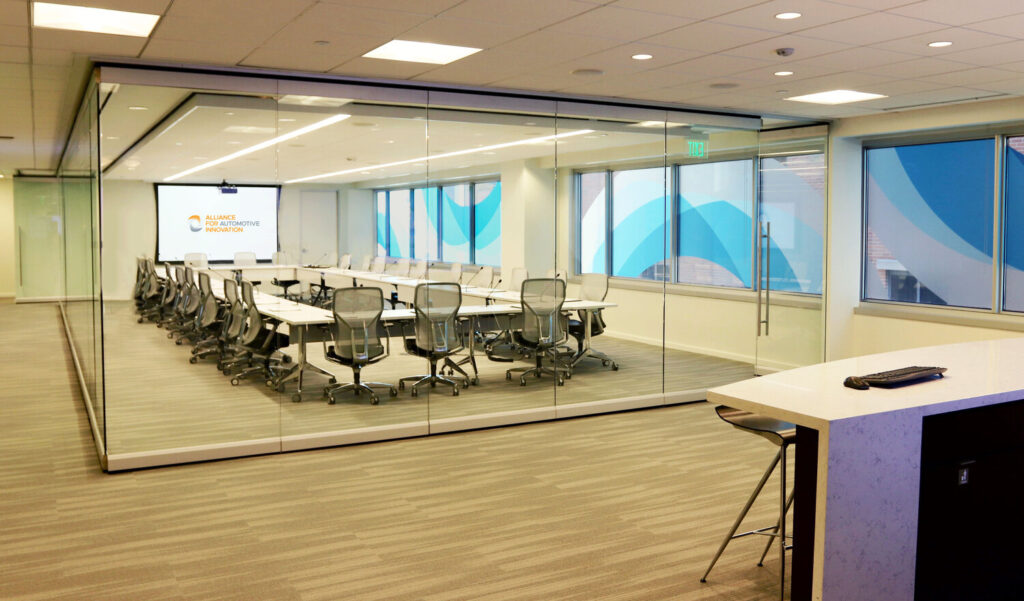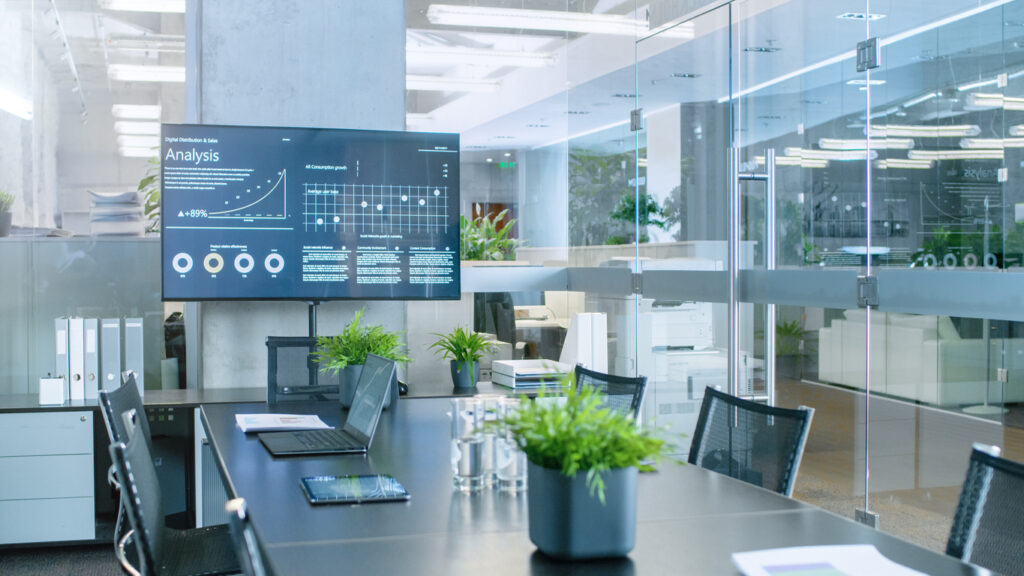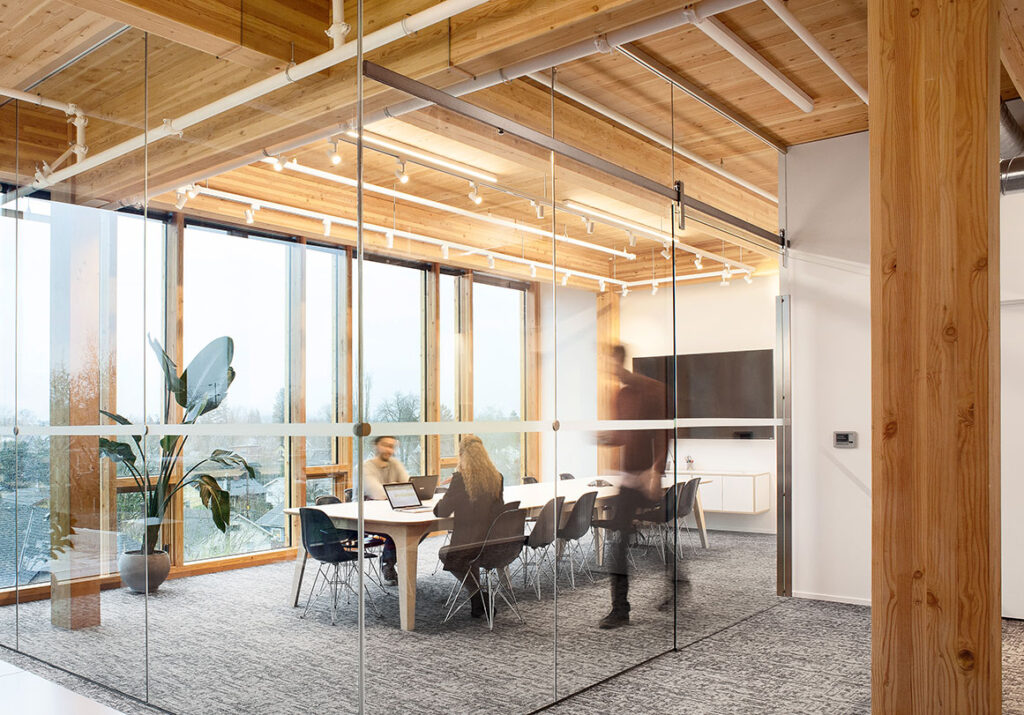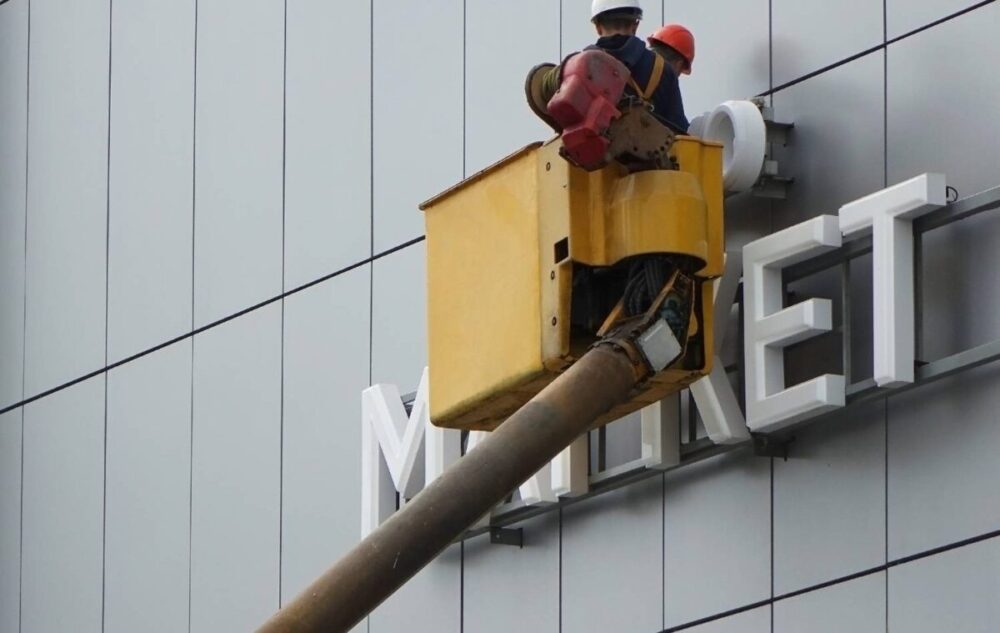In the world of corporate office design, few features have experienced such a dramatic transformation as glass conference rooms. These sleek, modern spaces have become a symbol of innovation and collaboration, with many companies seeing them as a must-have for their offices. This article will delve into the fascinating history of glass conference rooms, examining their emergence as a dominant design element, the impact of technological advancements on their evolution, and what the future holds for these unique spaces.
The Emergence of Glass as a Dominant Design Element

The Beginnings of Glass in Architecture
While glass has been utilized in architecture for centuries, it was during the 20th century that it truly began to take center stage. The advent of new manufacturing techniques allowed for the creation of larger, stronger panes of glass, which in turn led to a greater emphasis on incorporating this versatile material into building designs. Architects such as Ludwig Mies van der Rohe and Philip Johnson pioneered the use of glass in modernist structures, with iconic examples like the Farnsworth House and the Glass House showcasing the potential for glass to create a sense of openness and connection with the surrounding environment.
In addition to the influential works of Ludwig Mies van der Rohe and Philip Johnson, other notable architects and visionaries made their mark in the world of glass architecture. Pioneers like Renzo Piano, Norman Foster, and I.M. Pei embarked on daring projects that showcased the remarkable capabilities of glass. From the crystal-like transparency of the Louvre Pyramid to the soaring glass facades of skyscrapers, these architectural masterpieces captured the imagination and pushed the boundaries of what was deemed possible.
The use of glass and laminated glass in architecture not only allowed for an abundance of natural light to flood interiors but also facilitated a seamless connection between the built environment and the surrounding landscapes. It created a dialogue between the indoor and outdoor spaces, blurring the boundaries and bringing nature closer to the inhabitants.
The beginnings of glass in architecture paved the way for a new era of design, where transparency, lightness, and connectivity with the environment became key aspirations. With its rich history and limitless potential, glass continues to shape and redefine the architectural landscape, creating awe-inspiring structures that captivate and inspire generations to come.
The Shift Towards Open-Concept Office Spaces
As the 20th century progressed, office design began to shift away from the traditional model of closed-off, private offices towards more open, collaborative environments. This change in philosophy was partly driven by the rise of technology companies, which often valued innovation and teamwork over hierarchical structures. Glass conference rooms emerged as a popular solution for creating communal spaces that still provided a degree of separation and privacy. The inherent transparency of glass allowed team members to visually connect with one another, fostering a sense of unity and shared purpose.
The Symbolism of Glass Conference Rooms
The growing popularity of glass conference rooms also spoke to larger cultural trends around transparency and openness in the workplace. Glass came to symbolize a break from the old, opaque ways of conducting business, reflecting the increasing importance of collaboration, communication, and the free-flow of ideas. Companies that adopted glass conference rooms sought to send a message about their commitment to these values, using these visually striking spaces to reinforce their brand identity and corporate culture.
The Impact of Technological Advancements on Conference Room Design

The Integration of Audiovisual Equipment
As technology has become an increasingly integral part of business operations, conference room design has had to adapt to accommodate the growing need for audiovisual equipment. Glass conference rooms have proven to be particularly well-suited for this purpose, with their sleek, minimal aesthetic providing an ideal backdrop for the integration of high-tech devices. Flat-screen monitors, video conferencing systems, and interactive whiteboards can all be seamlessly incorporated into glass conference room designs, allowing for a more immersive and engaging meeting experience.
The Development of Smart Glass Technologies
One of the most exciting technological advancements to impact glass conference room design is the development of smart glass technologies. These innovative materials can switch between transparent and opaque states in response to an electrical current, offering a high degree of flexibility and control over privacy levels. By incorporating smart glass into their designs, companies can enjoy the best of both worlds: the visual openness and connectivity of a traditional glass conference room, and the ability to instantly create a more private, focused environment when necessary.
The Influence of Acoustic Engineering
A common concern with glass conference rooms is their potential for creating acoustic issues, such as echo and sound transmission. However, advances in acoustic engineering have led to the development of specialized glass products that can effectively mitigate these problems. Laminated glass, for example, features a layer of plastic sandwiched between two panes of glass, which can help to dampen sound transmission. Additionally, the use of sound-absorbing materials and clever design strategies, such as incorporating angled surfaces or strategically placed partitions, can further enhance the acoustic performance of glass conference rooms.
The Future of Glass Conference Rooms in the Era of Remote Work

Adapting to a Hybrid Work Model
As remote work becomes an increasingly prevalent part of the modern workplace, companies will need to adapt their office designs to accommodate a more flexible, hybrid work model. Glass conference rooms are well-positioned to meet this challenge, offering a versatile space that can support both in-person and virtual collaboration. By incorporating advanced videoconferencing technology and flexible furniture arrangements, glass conference rooms can serve as a hub for connecting on-site and remote team members, fostering a sense of unity and cohesion.
The Emergence of Modular Glass Systems
Another trend shaping the future of glass conference rooms is the growing popularity of modular glass systems. These customizable, prefabricated solutions offer an easy and efficient way to create flexible, adaptable spaces within the office environment. Companies can choose from a wide range of designs and configurations, allowing them to create a glass conference room that perfectly meets their needs and preferences. As the workplace continues to evolve, the ability to quickly and easily reconfigure spaces will become an increasingly valuable asset.
The Integration of Virtual Reality and Augmented Reality Technologies
As virtual reality (VR) and augmented reality (AR) technologies continue to advance, it is likely that they will begin to play a significant role in the way we interact and collaborate within office spaces. Glass conference rooms could serve as the perfect setting for incorporating these immersive tools, providing a sleek, futuristic backdrop for virtual meetings and presentations. By embracing these cutting-edge technologies, companies can take their collaborative efforts to new heights, transcending the limitations of traditional meeting formats.
In conclusion, the evolution of glass conference rooms has been a fascinating journey, marked by significant advancements in both design and technology. As companies continue to adapt to the changing demands of the modern workplace, it is clear that glass conference rooms will continue to play a central role in shaping the office spaces of the future. From their symbolic association with transparency and collaboration to their adaptability in the face of remote work and emerging technologies, these unique spaces have much to offer in terms of both form and function. By embracing the principles of sustainability and environmental responsibility, companies can ensure that their glass conference rooms not only look stunning, but also contribute to a brighter, greener future for us all.





